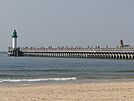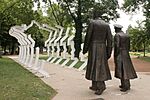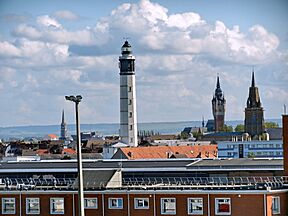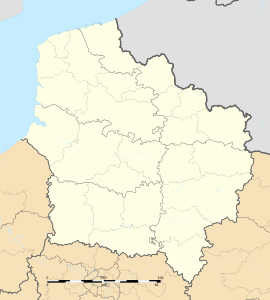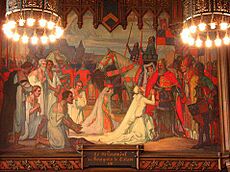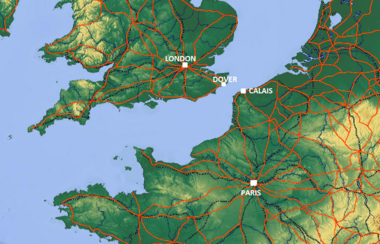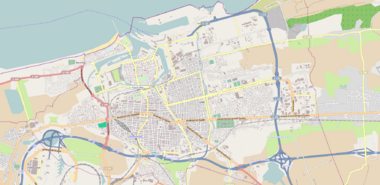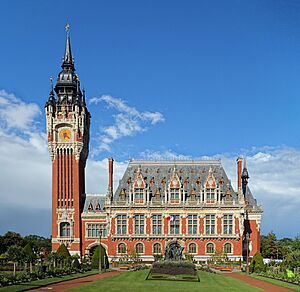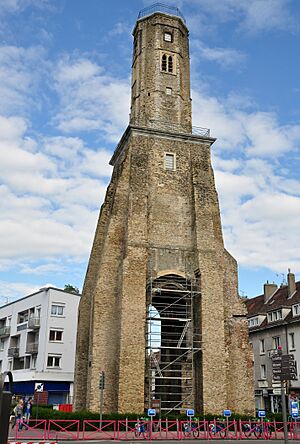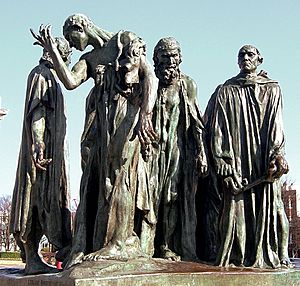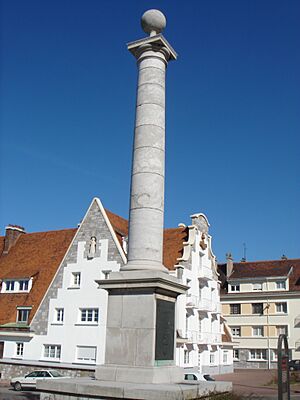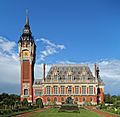Calais facts for kids
Quick facts for kids
Calais
|
|||
|---|---|---|---|
|
Subprefecture and commune
|
|||
|
|
|||
|
|||
| Country | France | ||
| Region | Hauts-de-France | ||
| Department | Pas-de-Calais | ||
| Arrondissement | Calais | ||
| Canton | Calais-1, 2 and 3 | ||
| Intercommunality | CA Grand Calais Terres et Mers | ||
| Area
1
|
33.5 km2 (12.9 sq mi) | ||
| Population
(2021)
|
67,380 | ||
| • Density | 2,011.3/km2 (5,209/sq mi) | ||
| Demonym(s) | Calaisiens | ||
| Time zone | UTC+01:00 (CET) | ||
| • Summer (DST) | UTC+02:00 (CEST) | ||
| INSEE/Postal code |
62193 /62100
|
||
| Elevation | 0–18 m (0–59 ft) | ||
| Website | City; Port | ||
| 1 French Land Register data, which excludes lakes, ponds, glaciers > 1 km2 (0.386 sq mi or 247 acres) and river estuaries. | |||
Calais is a French port city located in the Pas-de-Calais area. It's a very important city in this region, even though Arras is the main administrative center. In 2020, about 67,544 people lived in Calais itself, and over 144,000 in the wider urban area.
Calais is special because it sits right on the Strait of Dover. This is the narrowest part of the English Channel, only about 34 kilometers (21 miles) wide. This makes Calais the closest French town to England. On a clear day, you can easily see the famous White Cliffs of Dover from Calais!
Because of its location, Calais has been a major port for ferries between France and England for a long time. Since 1994, the Channel Tunnel also connects nearby Coquelles to Folkestone in England by train.
Calais has been a key place for trade and travel with England since the Middle Ages. It was even controlled by England for over 200 years after Edward III of England captured it in 1347. During this time, it became famous for making wool and was called the "brightest jewel in the English crown." This was because it was so important for trading goods like tin, lead, lace, and wool. France took Calais back in 1558.
Sadly, during World War II, much of the town was destroyed. In May 1940, German forces attacked and took control of Calais. They later built huge bunkers along the coast to launch missiles towards England.
Today, Calais is visited by over 10 million people every year. It's not just a transport hub; it's also a busy fishing port and still known for its lace industry.
Contents
What's in a Name?
The name Calais first appeared in history books in the late 1100s. Some people think a Latin name, Calesium, was used even earlier. This Latin name comes from Caletum, which was linked to an ancient tribe called the Caletes. Their name meant "the hard ones" or "the tough ones."
Over time, the spelling of Calais changed a lot in French and English. In English, it was often called Cales or Callis. Even William Shakespeare used Callice. The modern French spelling, Calais, became common in English too.
In the United States, some towns like Calais, Maine and Calais, Vermont still use the older English pronunciation, where you can hear the 's' sound at the end.
Calais Through Time
Early Days
We don't know much about the very first people who lived in the Calais area. Some say the Romans called it Caletum, but this isn't certain. Back then, Calais was actually an island in the North Sea!
Before the 900s, Calais was likely a small fishing village where people spoke Dutch. It had a natural harbor. Over time, canals were built to connect Calais to other trading towns. In 1181, Calais officially became a town.
English Rule (1347-1558)
In 1346, Edward III of England fought France and then laid siege to Calais. After a long siege, he captured the city in 1347. Edward III was very angry and wanted to punish the people of Calais. He agreed to spare them only if six important citizens would offer themselves for execution.
These six brave men came forward, ready to die for their town. But Edward's queen, Philippa of Hainault, begged him to spare their lives, and he did. This famous event is remembered by a sculpture called The Burghers of Calais by Auguste Rodin, which stands in the city today.
After taking Calais, King Edward sent most of the French people away and brought in English settlers. In 1360, a treaty officially gave Calais and some nearby areas to England forever. This area was known as the "Pale of Calais."
Calais became incredibly important for England, especially for the wool trade. It was called the "brightest jewel in the English crown" because of the money it brought in from trading tin, lead, cloth, and wool. Many people in Calais worked in the wool industry.
French Control Returns
In 1558, Henry II of France sent his army to take Calais back. They surprised the English and captured the city. Queen Mary I of England was very sad about losing Calais. The area around Calais was renamed the Pays Reconquis, meaning "Reconquered Country."
In 1596, the Spanish briefly captured Calais, but it was given back to France in 1598.
From the 1600s to World War I

Calais remained an important port, but other nearby ports like Boulogne and Dunkirk grew and became competitors.
The French Revolution in the late 1700s didn't cause much trouble in Calais. In 1805, Napoleon Bonaparte gathered part of his army in Calais, planning to invade Britain, but he never did.
During World War I, Calais was a very important port for the British army. It helped supply weapons and soldiers to the battlefront nearby.
World War II and Beyond
Calais was almost completely destroyed during World War II. In May 1940, German forces attacked the city. A small group of British and French soldiers bravely defended Calais for several days. This defense was very important because it kept many German tanks busy, which helped allow Allied soldiers to escape from Dunkirk.
During the German occupation, Calais was heavily fortified. The Germans believed the Allies would invade there. They built huge bunkers to launch V1 flying bombs and use large railway guns to attack England. The Allies bombed Calais heavily to trick the Germans into thinking the invasion would happen there, not in Normandy.
Calais was finally freed by Canadian troops in October 1944. After the war, most of the historic buildings were replaced with modern ones.
Recent Challenges: Migration
Since the late 1990s, many people seeking safety or a better life have arrived near Calais. They hoped to reach the United Kingdom by hiding in trucks, ferries, or trains. These people came from places like Afghanistan, Syria, and Eritrea.
They often lived in temporary camps, sometimes called the "Calais jungle." This situation caused some disagreements between the UK and France. The UK provided fences to help prevent people from trying to jump onto trains. In 2016, French authorities cleared the main camp. However, some people still arrive in Calais hoping to cross to the UK.
Where is Calais?
Calais is located on the Pas de Calais, which is the border between the English Channel and the North Sea. It's about 40 kilometers (25 miles) from Dover in England. On a clear day, you can see the White Cliffs of Dover across the channel.
Besides being a major port, Calais is a hub for many railway and highway networks. It's connected by road to other French cities like Arras and Dunkirk. Paris, the capital of France, is about 236 kilometers (147 miles) south of Calais.
The city has an old town area, Calais-Nord, which is surrounded by canals. The newer part, St-Pierre, is to the south.
Calais is part of the Côte d'Opale (Opal Coast). This is a beautiful part of the French coast with cliffs and dunes, similar to the white cliffs in England. Many artists and writers have found inspiration here because of its unique light.
Calais has a mild ocean climate. This means temperatures are not too extreme, and winters are cool with changing weather. It usually rains about 700 to 800 millimeters (27 to 31 inches) per year.
| Climate data for Calais (CQF), elevation: 2 m (7 ft), 1991–2010 normals, extremes 1991–present | |||||||||||||
|---|---|---|---|---|---|---|---|---|---|---|---|---|---|
| Month | Jan | Feb | Mar | Apr | May | Jun | Jul | Aug | Sep | Oct | Nov | Dec | Year |
| Record high °C (°F) | 15.0 (59.0) |
18.6 (65.5) |
22.6 (72.7) |
25.5 (77.9) |
31.1 (88.0) |
34.0 (93.2) |
39.9 (103.8) |
35.7 (96.3) |
32.0 (89.6) |
27.6 (81.7) |
20.2 (68.4) |
17.0 (62.6) |
39.9 (103.8) |
| Mean daily maximum °C (°F) | 7.4 (45.3) |
8.2 (46.8) |
10.4 (50.7) |
13.3 (55.9) |
16.4 (61.5) |
19.2 (66.6) |
21.7 (71.1) |
22.2 (72.0) |
19.3 (66.7) |
15.3 (59.5) |
10.9 (51.6) |
7.4 (45.3) |
14.3 (57.7) |
| Daily mean °C (°F) | 4.9 (40.8) |
5.4 (41.7) |
7.2 (45.0) |
9.3 (48.7) |
12.4 (54.3) |
15.1 (59.2) |
17.5 (63.5) |
17.8 (64.0) |
15.3 (59.5) |
11.9 (53.4) |
8.2 (46.8) |
4.9 (40.8) |
10.9 (51.6) |
| Mean daily minimum °C (°F) | 2.4 (36.3) |
2.7 (36.9) |
3.9 (39.0) |
5.3 (41.5) |
8.4 (47.1) |
11.0 (51.8) |
13.2 (55.8) |
13.5 (56.3) |
11.2 (52.2) |
8.4 (47.1) |
5.5 (41.9) |
2.5 (36.5) |
7.4 (45.3) |
| Record low °C (°F) | −14.0 (6.8) |
−11.3 (11.7) |
−5.9 (21.4) |
−5.0 (23.0) |
−0.4 (31.3) |
3.3 (37.9) |
4.9 (40.8) |
5.6 (42.1) |
0.9 (33.6) |
−5.7 (21.7) |
−7.1 (19.2) |
−13.2 (8.2) |
−14.0 (6.8) |
| Average precipitation mm (inches) | 55.3 (2.18) |
42.7 (1.68) |
39.9 (1.57) |
41.3 (1.63) |
54.5 (2.15) |
53.6 (2.11) |
54.8 (2.16) |
63.5 (2.50) |
63.0 (2.48) |
86.2 (3.39) |
90.7 (3.57) |
77.1 (3.04) |
722.6 (28.45) |
| Average precipitation days (≥ 1.0 mm) | 11.0 | 9.3 | 8.8 | 8.6 | 9.1 | 8.8 | 8.4 | 8.4 | 10.1 | 11.7 | 13.3 | 12.0 | 119.0 |
| Source: Meteo France | |||||||||||||
The city of Calais is divided into 13 main areas, called quartiers:
- Beau Marais
- Cailloux
- Calais-nord
- Quartier du Courgain Maritime
- Fontinettes
- Fort-Nieulay
- Gambetta
- Nouvelle-France
- Mi-voix
- Petit Courgain
- Plage
- Pont-du-Leu
- Saint-Pierre
Population of Calais
The number of people living in Calais has changed a lot over the years. For example, the population grew hugely from 13,529 in 1881 to 58,969 in 1886. This happened because the nearby city of Saint-Pierre-lès-Calais joined with Calais in 1885.
According to a 2017 census, Calais had 73,911 people. This was a small decrease from 1999.
| Historical population | |||||||||||||||||||||||||||||||||||||||||||||||||||||||||||||||||||||||||||||||||||||||||||||||||||||||||||||||||||||||
|---|---|---|---|---|---|---|---|---|---|---|---|---|---|---|---|---|---|---|---|---|---|---|---|---|---|---|---|---|---|---|---|---|---|---|---|---|---|---|---|---|---|---|---|---|---|---|---|---|---|---|---|---|---|---|---|---|---|---|---|---|---|---|---|---|---|---|---|---|---|---|---|---|---|---|---|---|---|---|---|---|---|---|---|---|---|---|---|---|---|---|---|---|---|---|---|---|---|---|---|---|---|---|---|---|---|---|---|---|---|---|---|---|---|---|---|---|---|---|---|
|
|
|
|||||||||||||||||||||||||||||||||||||||||||||||||||||||||||||||||||||||||||||||||||||||||||||||||||||||||||||||||||||
| Source: EHESS and INSEE | |||||||||||||||||||||||||||||||||||||||||||||||||||||||||||||||||||||||||||||||||||||||||||||||||||||||||||||||||||||||
Calais's Economy
Calais's location close to England has made it a very important port for hundreds of years. It's the main place where ferries cross between England and France. Most people traveling across the Channel use the Dover to Calais route.
The French entrance to the Channel Tunnel is also near Calais, about 4 kilometers (2.5 miles) west of the town. Calais has direct train links to Paris, which is 238 kilometers (148 miles) to the south. More than 10 million people visit Calais every year!
Historically, Calais was a big center for making and trading wool and cloth. Even today, there are two large lace factories in Calais, employing about 3,000 people. The town is also a notable fishing port. You can find several fish markets selling fresh seafood, including oysters, lobster, and smoked fish.
Famous Places in Calais
Place d'Armes
The Place d'Armes is one of the biggest squares in Calais. It's next to the old watchtower and used to be the main part of the city in medieval times. When Calais was under English rule, it was called Market Square. Today, it still hosts a lively market on Wednesdays and Saturdays.
Town Hall (Hôtel de Ville)
The town hall, called the Hôtel de Ville, is a very striking building in the center of Calais. It was built between 1911 and 1925 in a Flemish Renaissance style. This was to celebrate the joining of Calais and Saint Pierre in 1885.
Its beautiful clock tower and belfry are 74 meters (246 feet) tall and can be seen from the sea. The belfry rings throughout the day and has been protected by UNESCO since 2005. Inside, the hall has stained glass windows, paintings, and lovely decorations.
Notre-Dame Church
Église Notre-Dame is a large church that was first built in the late 1200s. Its tower was added later, around the 1300s or 1400s. It's thought to be the only church in France built in the English Perpendicular Gothic style.
The church has a mix of Flemish, Gothic, Anglo-Norman, and Tudor architectural styles. In 1921, former French President Charles de Gaulle married Yvonne Vendroux in this church.
The church was badly damaged during World War II, and some of its old altars and furniture were not replaced. It is now a protected historic monument.
Historic Towers
The Tour du Guet (Watch Tower) is one of the few buildings in Calais that survived World War II. It dates back to 1229 and is one of the city's oldest monuments. It's about 35 to 39 meters (115 to 128 feet) tall. An earthquake in 1580 split the tower, but it was repaired.
For centuries, it was an important lookout post for the city. From 1816, it also had a telegraph office that announced important news, like the death of Napoleon I. It also served as a lighthouse for a while.
The Calais Lighthouse (Le phare de Calais) was built in 1848 to replace the old watch tower as the main lighthouse. This 55-meter (180-foot) tall tower was made electric in 1883. You can climb 271 steps to reach the top! It's easy to spot by its white color and black top. It became a historic monument in 2010.
Old Forts
The Citadel was built between 1560 and 1571 on the site of an even older castle. It was meant to protect the city from invaders.
Fort Risban, located at the port entrance, was built by the English in 1346 during their siege of Calais. It was meant to stop supplies from reaching the city by sea. It was rebuilt in 1640. During World War II, it was used as an air raid shelter.
Fort Nieulay, built around 1525, was designed to protect the town by flooding the surrounding area if invaders approached. It was completely rebuilt in 1679.
Museums and Culture
Calais has several interesting museums:
- The Musée des Beaux-Arts et de la Dentelle de Calais (Museum of Fine Arts and Lace)
- The Cité internationale de la Dentelle et de la Mode de Calais (International City of Lace and Fashion) is in an old factory. It has workshops, a library, and even fashion shows.
- The Musée de la Seconde Guerre Mondiale (World War II museum) is in a former Nazi bunker built in 1941. It has twenty rooms filled with items and photos from World War II.
Calais also has theaters and cultural centers, including the Calais Theatre, which opened in 1905.
Monuments and Statues
In front of the town hall, you'll find a bronze sculpture called Les Bourgeois de Calais ("The Burghers of Calais") by Auguste Rodin. It remembers the six brave men who offered their lives to save Calais in 1347.
The Monument des Sauveteurs ("Rescuers' Monument") is a bronze sculpture from 1899 that honors rescuers. The Monument Le Pluviôse remembers the sinking of a submarine called Pluviôse in 1910, which caused the deaths of 27 people.
There's also a monument to Joseph Marie Jacquard, who helped develop the lace industry with his invention, the Jacquard loom. A tall column in the Courgain area remembers a visit by King Louis XVIII.
Historic Hotels
One famous old hotel in Calais was the Hôtel d'Angleterre, also known as Dessin's. It was very popular with British travelers.
The Hôtel Meurice de Calais was started in 1771 and was one of the first hotels in Europe to specifically serve wealthy British visitors.
Education in Calais
Calais has many schools for different age groups. These include primary schools, high schools, and vocational schools. There are also several colleges in the city, such as Collège Martin Luther King and Collège Jean Mace.
Sports in Calais
Calais used to have a well-known football (soccer) team called Calais RUFC. They were famous for reaching the final of the French Cup in the 1999/2000 season, where they played against Nantes. The team played at the Stade de l'Épopée, which can hold about 12,000 fans. Unfortunately, the club closed down in 2017.
Calais also has a rugby club, Amicale Rugby Calaisien. Basketball and volleyball are popular too, with both male and female teams. There's also a yachting club and an American football team called Les Seagulls.
Getting Around Calais
By Sea
The Port of Calais is the fourth largest port in France and the biggest for passenger traffic. It handles more than a third of Calais's economic activity. In 2007, over 41.5 million tons of goods and 11.52 million passengers passed through the port. Ferries sail from Calais to Dover, England, about every 30 minutes. A big project is underway to make the port even larger and able to handle almost all types of ships.
By Train
Calais has three train stations: Gare de Calais-Fréthun, Gare de Calais-Ville, and Gare des Fontinettes. Gare de Calais-Fréthun is the first stop in mainland Europe for the Eurostar train, which goes through the Channel Tunnel. Gare de Calais-Ville is closer to the port and has trains to other French cities like Boulogne and Lille.
By Road
Local bus services in Calais are provided by STCE. You can also find free car parking near the ferry terminal.
By Air
Calais has an airport and an airfield. The Calais–Dunkerque Airport is about 7 kilometers (4 miles) east of Calais, and Saint-Inglevert Airfield is about 13 kilometers (8 miles) southwest.
Twin Towns
Calais is "twinned" with several cities around the world. This means they have special friendly relationships and often share cultural exchanges.
 Bardejov, Slovakia
Bardejov, Slovakia Brăila, Romania
Brăila, Romania Duisburg, Germany
Duisburg, Germany Dover, Kent, United Kingdom
Dover, Kent, United Kingdom Wismar, Germany
Wismar, Germany Xiangtan, China
Xiangtan, China
Images for kids
See also
 In Spanish: Calais para niños
In Spanish: Calais para niños





